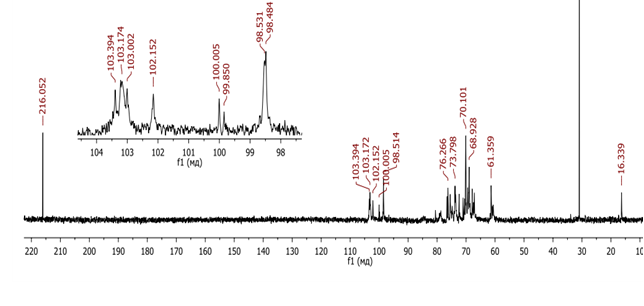ISOLATION, PHYSICO-CHEMICAL CHARACTERISTICS OF POLYSACCHARIDE ISOLATED FROM THE FRUIT BODY OF INONOTUS HISPIDUS
UDC 547.4:577.1:576.8
Abstract
The article is devoted to the study of polysaccharides isolated from the basidiomycete raw material I. hispidus and studying their physical and chemical properties. Water-soluble polysaccharides were isolated from mushroom raw materials by the method of sequential water extraction and the yield was 9.44%. Polysaccharides were separated into neutral fractions by ion exchange chromatography and purified from proteins and peptides. During the separation process, it was determined that the polysaccharide sample consisted of homogeneous polysaccharides, while the carbohydrate content of the purified polysaccharide sample was 99.4%. The carbohydrate composition of polysaccharides was determined, it was found that the polysaccharide consists mainly of glucose residues and contains minor amounts of fructose and rhamnose residues. Molecular weight and molecular weight distribution were determined by size exclusion chromatography. The Mw of the polysaccharide sample obtained was 18.7 kDa, the polydispersity index was 1.3. The results of IR-, 1H- and 13C NMR spectroscopic studies have shown that the polysaccharide, according to its structural characteristics, belongs to the β-glucan type polysaccharide having β-(1,3) and β-(1,6)-glycosidic bounds.
Downloads
Metrics
References
Simon B., Anke T., Sterner O. Phytochemistry, 1994, vol. 3, pp. 815–816.
Meng X., Liang H., Luo L. Carbohydrate Research, 2016, vol. 424, pp. 30–41. DOI: 10.1016/j.carres.2016.02.008.
Zjawiony J. Journal National Products, 2004, vol. 67, pp. 300–310. DOI: 10.1021 / np030372w.
Chen B. Carbohydrate Polymers, 2010, vol. 81, pp. 420–424. DOI: 10.1016/j.carbpol.2010.02.039.
Masuda Y., Kodama N., Nanba H. Mycoscience, 2006, vol. 47, pp. 360–366. DOI: 10.1007/S10267-006-0315-7.
Wang N. Тianjin Yiyao, 1989, vol. 17, pp. 534–536.
Khalilova G.A., Mukhitdinov B.I., Khaytmetova S.B., Normakhamatov N.S., Turayev A.S. Uzbekskiy khimicheskiy zhurnal, 2020, no. 5, pp. 88–94. (in Russ.).
Azimova L.B., Normakhamatov N.S., Khaytmetova S.B., Mukhitdinov B.I., Amonova D.M., Filatova A.V., Khalilova G.A., Kirgizbayev Kh.Kh., Turayev A.S. Khimiya rastitel'nogo syr'ya, 2019, no. 2, pp. 35–41. DOI: 10.14258/jcprm.2019024491. (in Russ.).
Khalilova G.A., Mukhitdinov B.I., Khaytmetova S.B., Azimova L.B., Normakhamatov N.S., Turayev A.S. Farmatsevticheskiy zhurnal, 2019, no. 4, pp. 72–83. (in Russ.).
Dubois M., Gilles K.A., Hamilton J., Robers P.A., Smith F. Analyt. Chem., 1956, vol. 28, pp. 350–356.
Staub A.M. Methods in Carbohydrate Chemistry, 1965, pp. 5–6.
Ye T. et al. Microbiology, 2008, vol. 154, pp. 2814–2826. DOI: 10.1099/mic.0.2008/020149-0.
Jianguo W., Yahong Y., Tianli Y. Carbohydrate Polymers, 2014, vol. 10, pp. 247–254. DOI: 10.1016/j.carbpol.2013.10.087.
Pan F., Su T.J., Liu Y., Hou K., Chen C., Wu W. International Journal of Biological Macromolecules, 2018, vol. 112, pp. 1073–1083. DOI: 10.1016/j.ijbiomac.2018.02.070.
Samanta S., Maity K., Nandi A.K., Sen I.K., Devi K.S.P., Mukherjee S. et al. Carbohydrate Research, 2013, vol. 367, pp. 33–40. DOI: 10.1016/j.carres.-2012.12.002.
Wang Y., Liu Y., Yu H., Zhou S., Zhang Z., Wu D. et al. Carbohydrate Polymers, 2017, vol. 167, pp. 337–344. DOI: 10.1016/j.carbpol.2017.03.016.
Vidal S., Doco T., Williams P., Pellerin P., York W., O’Neill M., Glushka J., Darvill G., Albersheim P. Carbohydrate Research, 2000, vol. 326, pp. 277–294. DOI: 10.1016/s0008-6215(00)00036-7.
Muhitdinov B., Heinze T., Normakhamatov N., Turaev A. Carbohydrate Polymers, 2017, vol. 173, pp. 631–637. DOI: DOI: 10.1016/j.carbpol.2017.06.033.
Muhitdinov B., Heinze T., Turaev A., Koschella A., Normakhamatov N. European Polymer Journal, 2019, vol. 119, pp. 181–188. DOI: 10.1016/j.eurpolymj.2019.07.030.
Dong Q., Wang Y., Shi L., Yao J., Li J., Ma F., Ding K. Carbohydrate Research, 2012, vol. 353, pp. 100–105. DOI: 10.1016/j.carres.2012.02.029.

Copyright (c) 2021 chemistry of plant raw material

This work is licensed under a Creative Commons Attribution 4.0 International License.

This work is licensed under a Creative Commons Attribution 4.0 International License.
The authors, which are published in this journal, agree to the following conditions:
1. Authors retain the copyright to the work and transfer to the journal the right of the first publication along with the work, at the same time licensing it under the terms of the Creative Commons Attribution License, which allows others to distribute this work with the obligatory indication of the authorship of this work and a link to the original publication in this journal .
2. The authors retain the right to enter into separate, additional contractual agreements for the non-exclusive distribution of the version of the work published by this journal (for example, to place it in the university depository or to publish it in a book), with reference to the original publication in this journal.
3. Authors are allowed to post their work on the Internet (for example, in a university repository or on their personal website) before and during the review process of this journal, as this may lead to a productive discussion, as well as more links to this published work.











